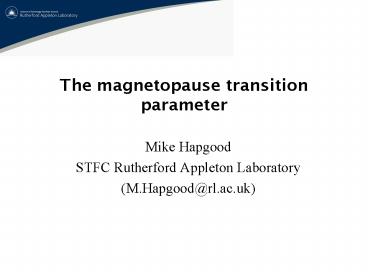The magnetopause transition parameter - PowerPoint PPT Presentation
1 / 41
Title:
The magnetopause transition parameter
Description:
TP developed in late 80 & 90s using AMPTE data. Ne/Te (particularly Te ... electron anisotropy (|| - )/ (Why does it work? Reconnection! The anti-correlation ... – PowerPoint PPT presentation
Number of Views:39
Avg rating:3.0/5.0
Title: The magnetopause transition parameter
1
The magnetopause transition parameter
- Mike Hapgood
- STFC Rutherford Appleton Laboratory
- (M.Hapgood_at_rl.ac.uk)
2
STRUCTURE
- Background and review
- Subtle issues
- Thoughts for future
3
BACKGROUND
- TP developed in late 80 90s using AMPTE data
- Ne/Te (particularly Te?) anticorrelated in LLBL
- Reported from mid 1970s
- TP tracks the anticorrelation
- Linear fit (Bryant Riggs, 1989)
- Polynomial fit (Hapgood Bryant, 1992), e.g. n3
- TP orders the LLBL!
- magnetic field components
- bulk velocity components
- electron anisotropy ( - ?)/ ( ?)
- Why does it work?
- Reconnection!
4
The anti-correlation
TP tracks anti-correlation. Normalise 0 to 100.
5
Ordering B, V Ti
Enhanced B field
TP ordering multiple m/p crossings
6
ENHANCED VELOCITIES
More ordering
Accelerated flows?
LLBL
fB -40
sheath
7
Time-ordered spectra
8
TP-ordered spectra
9
Ordering electron spectra
10
WHY DOES IT WORK?
- Anti-correlation suggests mixing of two plasmas
- Magnetosphere magnetosheath
- Diffusion
- no solution found
- Reconnection
- Lockwood model
11
TRANSITION PARAMETER MODEL
Lockwood model mixes of ions and electrons from
magnetosheath and magnetosphere on newly-opened
flux tubes by time-of-flight. Use potential
barrier to maintain quasi-neutrality.
magnetospheric plasma
sheath plasma
Magnetosheath
Magnetosphere
Potential barrier
B
12
MODEL RESULTS
Escape of hot sphere electrons
Arrival of sheath plasma
TP is measure of time since reconnection and thus
position in open LLBL gt this provides ordering
of independent parameters (V, B, )
13
REPRISE
Role of non-linearity - theory suggests this
branch is due to loss of hot electrons.
14
OPEN BL MODEL
Exterior separatrix
Open BL model with sphere Alfvén speed gt sheath
Alfvén speed.
ts-to is time since field line opened - also
measure of depth in LLBL
Exterior Alfvén wave (m/p)
Interior Alfvén wave and separatrix
15
- Subtle issues
16
Select data - exclude other regions
17
What if there are 3 plasmas?
4/31 cases gave no anticorrelation (e.g. blue to
left). Anticorrelation appears if low energies
excluded (as in red).
The 4 cases have large fluxes of cold electrons -
also seen by IRM. Thus mixing three , rather than
two, plasma populations. From plasmasphere.
18
Order returns!
Enhanced B field?
Accelerated flows?
Ti low in sphere gt cold component
TP ordering in problem case
19
- Thoughts for future 1
- Looking for reconnection layer signatures
20
TP and the WALEN TEST
Plots use data with TP from 10 to 14
Consistent slopes with mean 5.9 2.0 km s-1 nT-1
in good agreement with theoretical magnitude
significant correlations (lt0.1 by chance)
components of field-line (de Hoffmann-Teller or
dHT) velocity
21
ORDERING OF DHT VELOCITY
magnitude decreases with increasing TP gt
increases with time since reconnection
Result consistent with field lines accelerated
away from sub-solar region (as expected for
reconnection)
azimuth is nearly constant in dawnward direction
22
Looking for the interior wave
Walen test on 28 Oct FTE
Interior wave (slow mode) ??
Model of recon layer (not MHD!)
?
Exterior wave (Alfven wave) magnetopause
23
- Thoughts for future 2
- Understanding the counter-streaming electrons
24
(No Transcript)
25
(No Transcript)
26
(No Transcript)
27
C/S electrons open model
- Counter-streaming electrons (50-500 eV) are a
ubiquitous feature of boundary layer - Well-ordered by TP low energy cut-off close
near top of energy range for sheath electrons,
potential barrier in Lockwood model - Suggests source outside magnetosphere as below
- Outer limit of c/s at barrier gt near the limit
of penetration of magnetosheath ions, marked by
the ion velocity shear
acceleration?
counter-streaming electrons
sheath plasma
Magnetosheath
Magnetosphere
B
Potential barrier
28
- Thoughts for future 3
- Other features
29
- Other spectral features in TP ordered spectra
- High energy outflow sometimes seen in narrow
range near magnetopause (TP10) - Cold electrons sometimes seen at TP gt 50
outflow from plasmasphere/ionosphere? - Ne/Te anticorrelation seen elsewhere
- Interplanetary CME/magnetic clouds (also c/s
electrons) - Dayside plasmasheet
- Can TP be applied?
30
- Thoughts for future 4
- Some personal observations
31
- Many boundary layer studies still
stamp-collecting - Labelling features in time series rather than
building physics framework - Many techniques, e.g. cartoons of B topology
- Can the TP technique contribute to this?
- Does the magnetospheric boundary layer have an
inner boundary? - Magnetopause provides clear outer boundary
- Is there any physical reason for an inner
boundary? - Open/closed field line if meaningful, consider
propagation times - Or does layer just meld into magnetosphere?
32
- SPARES
33
TP tool adapted for Cluster PP
34
(No Transcript)
35
BACKGROUND
- Use data taken by the AMPTE-UKS and -IRM
spacecraft in 1984/5 - UKS electron data from RAL instrument
- UKS magnetic field data, courtesy Imperial
College - UKS ion data, courtesy MSSL
- IRM data, courtesy MPE Garching and TU
Braunschweig - Application to Cluster data planned
CCE
UKS
IRM
36
Enhanced B field
TP ordering multiple m/p crossings
37
UKS observed LLBL across dayside
38
(No Transcript)
39
TP ordering one main m/p crossing two excursions
Accelerated flows?
40
(No Transcript)
41
- Abstract The transition parameter was developed
in the 1990s as a way to re-order measurements in
the boundary layer between the magnetosphere and
magnetosheath. It tracks the mixing of electron
populations in this layer but at the same time
brings remarkable order to independent plasma
parameters such as magnetic field and bulk
velocity. The talk will review the development of
the transition parameter and then discuss ideas
for its future application.































